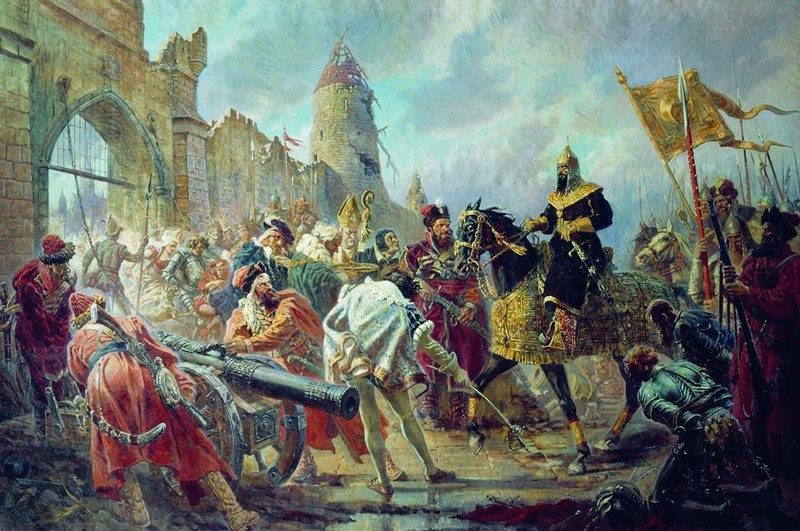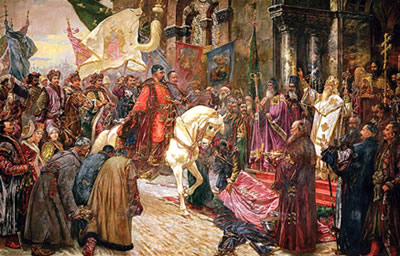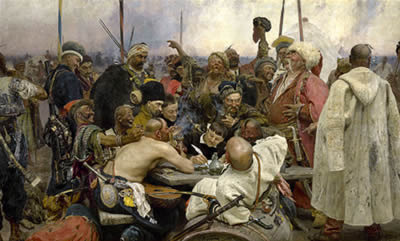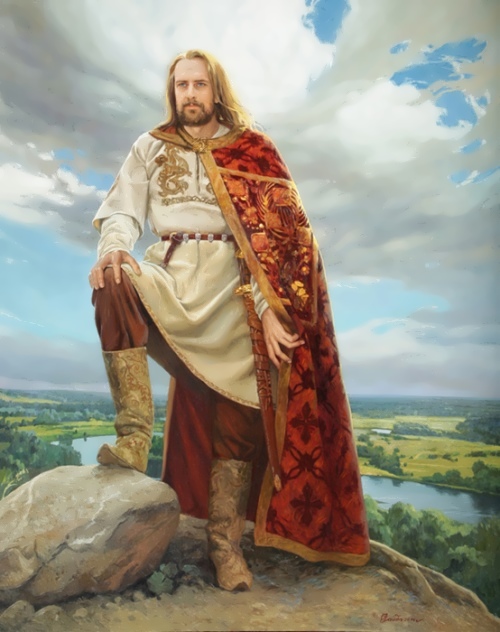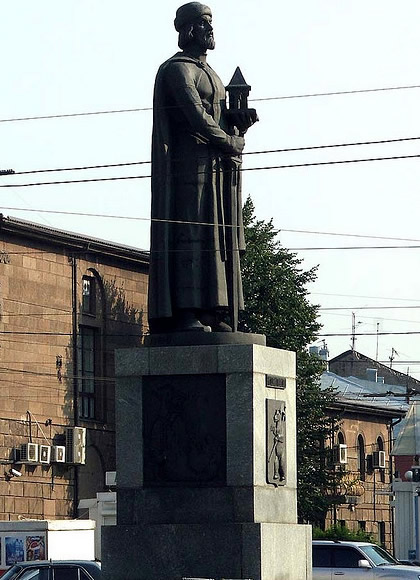The death of Czar Feodor III (1676–82) created a persoalan for the continuation of the Romanov dynasty in Russia since Fedor left no heirs; the debate developed concerning Ivan or Peter as successor.
Ivan was Fedor’s brother, but Ivan, who was 16 years old, was mentally and physically handicapped. Peter was the half brother of Ivan and had the support of many of the boyars and the patriarch Joachim, since this healthy 10-year-old offered stability to the Russian throne.
The Zemsky Sobor, an assembly of boyars, was assembled and voiced its support for Peter, but Sophia, Feodor’s sister, refused to allow Peter to be crowned as czar and attempted to incite the Streltsi, a regiment of guardsmen, to turn against Peter. On May 15, 1682, the Streltsi, upon hearing rumors that Ivan and a number of boyars were murdered, rebelled and stormed the Kremlin.
The Streltsi swore their loyalty to the Romanov family after Ivan Naryshkin and Doctor Van Gaden were brutally murdered. These two individuals were killed because the Streltsi believed they played a role in the presumed death of Ivan.
Following these murders, the Streltsi decided that Ivan and Peter would corule Russia, with Ivan acting as the senior czar and Sophia as the regent over both czars. The double coronation ceremony was held on May 26, 1682.
Sophia’s control over the Russian government quickly deteriorated with mounting tension between Sophia and Peter as Peter tried to assert his authority over her. In August 1689, Sophia called up some of the palace guards to protect her from a suspected attack from supporters of Peter.
This intensified the situation, because a number of people loyal to Peter believed that these guards were called up to attack him. Peter fled for refuge to the Monastery of the Holy Trinity, where he rallied a sizable force. Sophia, fearful of Peter’s increasing strength and of her declining support, capitulated.
Peter’s mother, Natalia, was selected to replace Sophia as the regent of the czars, but her regency was short, as she died in 1694. Ivan died shortly later in 1695, leaving Peter as the czar of Russia, and in a position to pursue his own policies.
Military Might
Peter’s first interests were against the Crimean Turks, as Peter was anxious to acquire access to the Black Sea so that Russia could trade with Europe throughout the whole year. The battle against the Turks at Azov in 1695 was a failure despite the fact that Peter assembled an army of approximately 31,000 men to attack Azov, and another 120,000 men to fight near the Dnieper River.
The reason for the failure was that the Turks could still ship supplies to Azov via water transport. Peter decided to correct this oversight in his strategy and collected money from monasteries and boyars to build a Russian naval fleet. The second attempt to take Azov in June 1696 with an army of 80,000 soldiers and a fleet was successful.
With the campaign against the Turks a success, Peter decided to focus his attention toward the West. In 1697, Peter and an entourage of 250 Russians toured Europe to examine Western knowledge and technology. Peter was impressed with the wealth Holland was able to acquire through its trading access and commercial fleet.
This wealth left such an impression on Peter that he was determined to emulate this success by constructing his own commercial fleet. He wanted to give Russia a window to the West via trade and to acquire more European technology to strengthen Russia.
Peter also wanted to import Western culture to Russia; he forced the nobles to shave their beards, changed the Russian calendar to conform to the European calendar, and made the Russian New Year conform to the European New Year.
In fact, the historian Paul Bushkovitch has credited Peter with introducing modern culture and political thought to Russia. Peter was also able to create a stronger state by making the Eastern Orthodox Church subservient to the Russian government.
The money Peter seized from monasteries and the reformed tax system helped Peter to build an academy to improve the education system in Russia. Peter was also able to bring order to the Russian social hierarchy by formulating the Table of Ranks in 1722, which determined an individual’s status in Russian society.
Moving West
Instead of pursuing Russian expansion to the south against the Turks, as previous Russian foreign policy dictated, Peter moved west, initiating hostilities against Sweden. The Great Northern War against Sweden dominated much of Peter’s reign.
In order to defeat the Swedish, Peter built a large army based on the same model as his Preobrazhenskii regiment, which had Western-style uniforms, training, and promotion through the ranks based on merit instead of birth. Poland sent a declaration of war to the Swedish government in January 1700, and Denmark quickly followed suit.
These two countries gave Peter allies in a war against Sweden, initiated when the Russian government declared war against the Swedish government on August 20, 1700. Unfortunately for Peter, the Danes sued for peace on August 20, 1700, leaving Russia and Poland to fight against the Swedish empire without this valuable ally.
As this alliance between Poland and Russia developed, Charles XII of Sweden reviewed his plans to protect his empire. Unfortunately, he was not able to recognize the major threat to his country’s boundaries. The Swedish strategy during the Great Northern War consisted of concentrating the main bulk of their forces against the Polish armies while Charles relied upon a token force to limit the Russian advance in the east.
It is true that the Swedes quickly attacked and defeated a Russian force at Narva on November 30, 1700. At this battle, a small Swedish force of 10,000 soldiers was able to overwhelm a Russian force of 40,000 men and seize the battlefield.
Despite this victory, the Swedes did not follow up their attack with further pressure against the Russians. The Swedish strategists preferred to concentrate their war effort against the Poles. It took the Swedes eight years to launch their second invasion into Russian territory.
Following his victory at Narva, Charles maintained a Swedish force of 15,000 men to protect his Baltic possessions. This force proved to be inadequate in the defense of the eastern portion of his empire against the armies of Peter. In January of 1702, Peter gained some momentum with his victory over the Swedes at Errestfer.
This battle had major consequences for the Swedish war effort since its army lost 3,350 soldiers. This Swedish defeat was compounded by another Swedish rout half a year later. This defeat cost the Swedish army a significant number of soldiers and provided the stimulus Peter needed in order to expand into the Baltic area.
Peter was able to strengthen Kronstadt after the capture of the fortresses of Nyenskans and Nöteborg. Peter was determined to hold on to his acquisitions in the Baltic region and give Russia closer ties with the rest of Europe by founding St. Petersburg in 1703, which became the future capital of Russia.
It is important to note that the Russian armies acquired more than territorial gains from this Baltic campaign. Through these military victories, the Russians were able to acquire more experience and confidence, as well as increase the size of their army.
When Charles XII finally turned his attention toward the Russian front, Peter had already established himself on the eastern coast of the Baltic Sea. The eight-year gap between the two Swedish invasions of Russian territory provided Peter with a reprieve in which he could strengthen his armies.
The number of cavalry regiments increased from two in 1700 to 34 regiments at the time of Charles’s return. As Charles advanced through the Ukraine, Peter was obliged to follow a scorched earth policy in order to stall for time and demoralize the invading Swedes.
Vicious methods were employed to deprive the Swedes of anything of use as the town of Dorpat was destroyed after the inhabitants were forcibly moved eastward and Russians were forbidden to provide Swedish troops with provisions.
Swedish Defeat
On May 11, 1709, the Swedish army unknowingly began a siege that would lead to the capitulation of the Swedish government 12 years later. The Poltava battle accurately foreshadowed the decline of Swedish power in the affairs of the Baltic as this battle cost the Swedish army 9,700 soldiers. This is a significant number of men compared to the 4,545 casualties the Russian army endured.
The consequences of this battle were further devastating to the Swedes. On July 1, 1709, fully 20,000 Swedes surrendered to the Russian armies at the town of Perovolochina. The Russians were unable to capture their royal opponent as Charles XII, who abandoned a significant portion of his army, fled south to the Ottoman Empire.
Poltava is recognized by scholars as a battle that not only changed the course of the Northern War, but completely altered the balance of power in northeastern Europe. It must be noted the governments of Western Europe were anticipating not only the destruction of the Russian army, but the further expansion of Swedish influence into eastern Europe.
The consequences of the Battle of Poltava ended any hope of imposing Swedish influence on the Russians. Not only did the Swedes lose a substantial portion of their army, but the old alliance against them was strengthened.
In this respect, Peter shifted from a passive role during the first alliance into a more active role. Peter, who encountered Augustus on the Vistula River, agreed to help his former comrade reclaim his throne since he was deposed following the Swedish victory over the Poles at Kliszow in 1702.
Peter attempted to make the Polish throne more secure to the family of Augustus by making the Polish monarchy a hereditary position. This illustrates the massive degree of power Peter now possessed in the internal affairs of the Polish government. The Danes, already allied to Augustus, wished to restore the old balance of power in northern Europe.
Invasion of Finland
Peter was able to use his gains in the Baltic to their fullest potential as he launched an invasion of Finland in order to strengthen his position at the upcoming peace negotiations with the Swedish government. The Russians won a remarkable victory against the Swedish at Storkyro in March 1714.
This land victory was followed by a Russian naval triumph over the Swedish navy at Gangut. In 1718, the Swedish government faced another threatening situation: Charles XII died during a battle in Norway. Ulrika, Charles’s sister, faced increasing pressure resulting from Peter’s invasions of the Swedish heartland.
The Russians were also enlarging the size of their Baltic fleet at an alarming pace. These threats compelled the Swedish government to end the war against the Russians. The Russians were able to gain a significant degree of power in the Baltic region from the Treaty of Nystadt.
The agreement between these two powers allowed the Russians to take possession of several islands, the territories of Livonia, Estonia, Ingermanland, and a section of Karelia. The Russians were given significant influence in Baltic affairs since they kept the fortress of Viborg.
More important, the Russian czar was regarded as an imperial monarch by the Prussians and the Dutch. Even the Swedes and other western Europeans eventually acknowledged this title.
Peter’s death on January 28, 1725, brought uncertainty to the succession of a new ruler for two reasons. Peter did not have a male heir to succeed him, and he failed to nominate his successor before he died. Peter’s only son and heir to the throne, Alexei, died on June 26, 1718, as a result of the torture inflicted on him for his rebellious attitudes.
Alexei was an outspoken critic of Peter’s reforms and feared the wrath of his father, resulting in his flight to Austria in 1716. Despite the fact that he was plotting against his father, Alexei was eventually persuaded to return to Russia and was imprisoned in the Peter and Paul Fortress, where he later died. His wife, Catherine, was nominated to succeed Peter since she had the support of a number of Peter’s advisers and the Imperial Guard.



